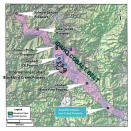The Biggest Winner Of The Clean Energy Race
The rise of clean energy is creating a supply crunch for a little-known resource - COBALT.
Largely ignored, there hasn't been any exploration of cobalt in years. That's because it's typically found alongside industrial metals like copper and nickel, neither of which has experienced strong demand over the last few years.
Demand for cobalt is soaring.
It is a lesser-known yet essential component of electric vehicle batteries. And for the first time in history, the world's supply isn't keeping up with demand.
Additionally, today's consumers and investors are increasingly socially conscious. Companies like Apple (NASDAQ:AAPL) are under increasing pressure to source materials from conflict-free jurisdictions.
The current challenge is that there are very few cobalt producers working in ethical jurisdictions – in fact, 50 percent of cobalt is currently sourced from the Democratic Republic of the Congo (DRC), a country with an appalling record of both mining practices and human rights.
One company poised to meet the growing need for cobalt is US Cobalt (formerly Scientific Metals) (TSX:USCO; OTC:SCTFF). The company has recently attracted the attention of an influential group of large investors.
This $35 million market cap company is sitting on a project with an anticipated 1.3 million tons of cobalt. The price of cobalt is currently $25 USD/lb – which is almost 100 percent more than it was 6 months ago. There are indications in US Cobalt's historical data that there could be as much as five times that current estimate sitting on the property.
"Clean Money" Investing Fueling Demand
A relatively new form of investing is quickly gaining in popularity. It's called Environment, Social, and Governance investing. Those in the finance word call it ESG for short.
ESG started slowly ten years ago and has grown into a bona fide investing methodology. Over the last decade, ESG assets in the U.S. have grown 376 percent from $1.7 trillion to $8.1 trillion. In part, this growth has been driven by a generational shift in assets to millennials who are attracted to the ESG ethos.
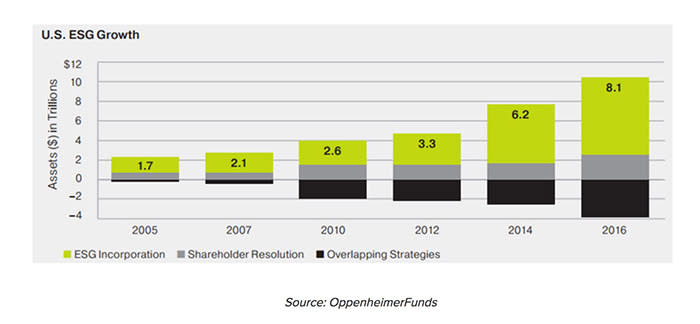
ESG assets under management are seeing continued growth as investors increasingly identify with its stated purpose. PricewaterhouseCoopers believes ESG funds will have over $100 trillion in global assets under management by 2020.
As an example, shares of Elon Musk's electric car manufacturer Tesla (NASDAQ:TSLA) have gained 1,028 percent in the last five years. Its stock price is up 44 percent in the last year alone.
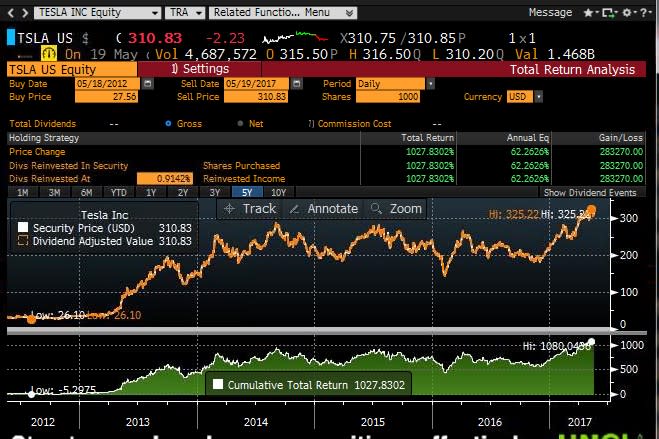
Source: Bloomberg
Producers of certain commodities are benefiting from this unprecedented demand
Clean tech companies have driven up both demand and the prices of the metals that are used to manufacture batteries and storage panels.
Traditional car companies such as Ford Motor Company (NYSE:F), Toyota Motor Corporation (NYSE:TM) and General Motors Company (NYSE:GM) have entered the electric car arena. Mercedes-Benz (Daimler AG (OTC:DDAIF) is challenging Tesla, not only for electric car market share but, more recently, the solar home battery market as well. All of these producers need batteries, and the battery makers need more of the metals used to manufacture them.
A dozen battery gigafactories are due to come online to try and meet the EV battery demand. Where will the cobalt needed to manufacture these batteries come from when there is a well-documented shortage already?
This perfect storm has created a supply shortage for several industrial metals. As the factories and now investors have scrambled to acquire enough to meet demand, prices have been driven higher.
As an example, the price of lithium, one component of EV batteries, rose over 400 percent between 2005 and 2016. It was 2016's shining star, with shares of lithium miners surging across the board.
Shares of lithium miner Sirios Resources Inc. shot up 1,170 percent in 2016.
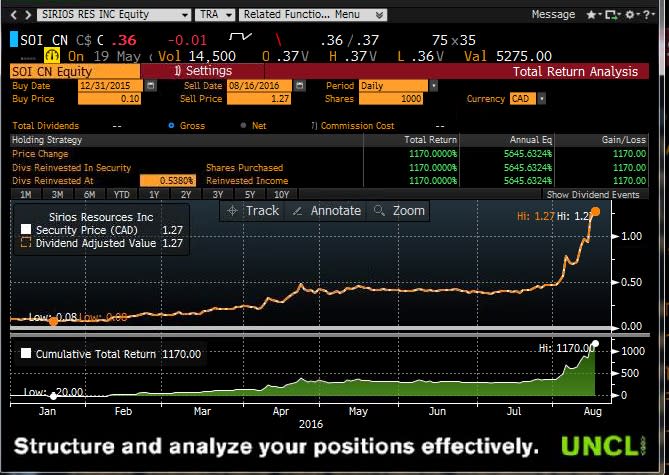
Source: Bloomberg
And shareholders of Rock Tech Lithium could have captured even larger gains. In 2016, its stock price skyrocketed by 2,989 percent!
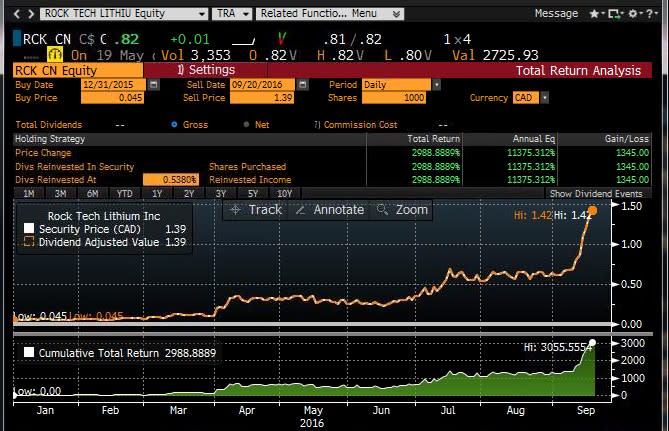
Source: Bloomberg
Cobalt is integral to the production of lithium-ion batteries. The attention that was focused on sourcing lithium has now turned to cobalt. The time to address this shortage and capitalize on the opportunities presented is now.
The Trend is This Mining Vet's Billion Dollar Friend
Cobalt makes up around 35 percent of the lithium-ion batteries used to power electric vehicles. And as EV production has scaled, so has cobalt demand.
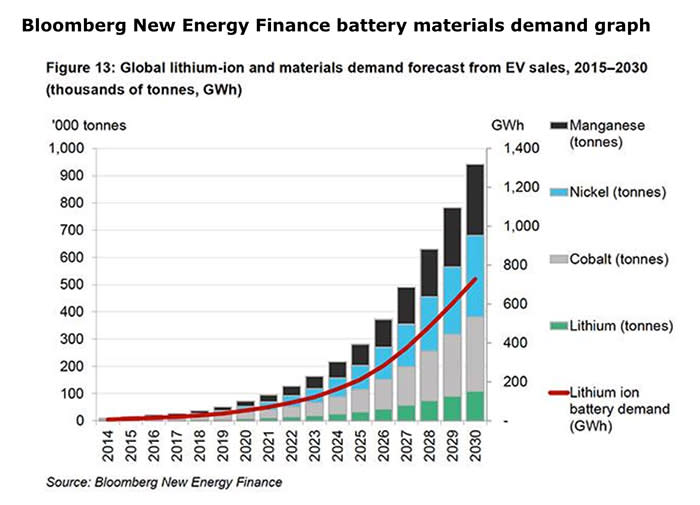
Recognizing the trend and the opportunity to capitalize on the growing need for cobalt, seasoned mining veteran and US Cobalt (TSX:USCO; OTC:SCTFF) CEO, Wayne Tisdale and his team realize that the price of cobalt is about to play catch up to lithium.
They have a history of spotting trends. And they've been right five times before.
Tisdale and his team have created $2.7 billion in value for their investors by building and selling five different companies over the last 15 years.
- Rainy River (gold) – peaked at $1.2 billion
- Xemplar (uranium) – peaked at $1 billion
- Ryland Oil (oil and gas) peaked at $300 million
- Webtech Wireless (technology) – peaked at $300 million
- Pure Energy (lithium) – peaked at $65 million
How do they do it? Once a trend becomes clear, they get in early. This world-class team acquires, develops and finances the right assets.
The Right Metal in the Right Place, at the Right Time
Today, about 50 percent of the world's cobalt supply comes from the war-torn Democratic Republic of Congo (DRC). This central African country's natural resources, such as cobalt, are being mined in war zones, with the profits being used to fund war.
Even worse, most of the DRC's cobalt production is mined by children as young as seven years old. They work in life-threatening conditions and are paid as little as a dollar a day.
Like Sierra Leone's notorious "blood diamonds," companies and their investors are increasingly searching for alternative supply, to avoid purchasing "conflict metals."
Last year, business group Electronic Industry Citizenship Coalition (EICC) announced its new Responsible Raw Materials Initiative. The EICC called for companies to treat cobalt as a "conflict" mineral under their initiative.
Nineteen EICC-member companies signed pledges to support the initiative. That included Apple, Dell and Ford Motors. Their customers have made it clear that they don't want to buy products that directly or indirectly contribute to the exploitation of children in the DRC.
This means that Fortune 500 companies are looking elsewhere for cobalt, and when 50 percent of the cobalt supply from the market is removed, an enormous supply problem is created.
The price of "ethical" cobalt is going to go much higher.
Electric vehicle adoption and the ethical cobalt movement are two reasons that Macquarie Research analysts project there will be an 885 ton deficit of cobalt next year. That deficit will grow to 3,205 tons in 2019 and 5,340 tons by 2020.
US Cobalt is in the right jurisdiction (Idaho, USA) to be a part of this ethical solution.
A Socially Conscious Miner is Born
While hedge funds have been hoarding DRC-sourced supplies of the metal, US Cobalt is exploring for ethical sources of it.
The company recently acquired the Iron Creek Cobalt Property located in the Idaho Cobalt Belt. The Idaho Cobalt Belt is home of Blackbird Mine, the only primary cobalt mine in the U.S. to date. The Blackbird Mine was operational between 1902 and 1968.

Source: US Cobalt
Besides having the advantage of being in a politically stable and conflict-free zone, the property has already seen a substantial amount of historical exploratory work. In the past, there have been approximately 30,000 feet of diamond drilling and 1,500 feet of underground mining.
US Cobalt (TSX:USCO; OTC:SCTFF) has obtained all of the data from previous mining operators including Cominco, Hanna Mining and Noranda.
The property has historic cobalt indications of 1.3 million tons grading 0.59 percent of cobalt, a high grade in North American mining terms. There are encouraging indications that there may be as much as 10 million tons on the property.
The company is currently compiling and assessing the data in order to bring it to current geological standards and will conduct surface core drilling this year. This surface core drilling will target the known mineralized zones in order to assess and confirm the historic cobalt estimates.
US Cobalt (TSX:USCO; OTC:SCTFF) will also conduct geophysical surveys to locate additional drill targets and explore for additional mineralization in previously unexplored areas. As a result of a May 2017 private placement, all funds are on hand to complete this program.
Big Money Discovers this Ethical Cobalt Play
The company is fully financed to execute its 2017 exploration plan.
On May 17th, the company announced that it had raised $1.7 million at $0.85 per share. The funding came from institutional investors. The private placement represented the first time these funds have invested in US Cobalt.
The funding comes on the heels of an impressive run in the price of US Cobalt's stock. The share price took off from a low of $0.16 on December 1, 2016 to a high of $1.13 on May 2, 2017, representing an increase of over 600 percent over five months.
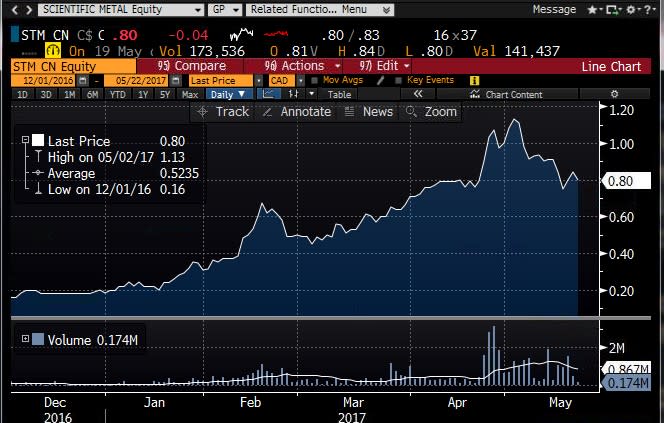
Source: Bloomberg
Since then, the stock has pulled back briefly, giving investors the rare opportunity to invest at the same price as the professionals.
Large institutional investors are already hoarding cobalt in recognition of the current and future shortages. Their next target might be the actual producers.
US Cobalt (TSX:USCO; OTC:SCTFF) has an outstanding management team with a track record of creating value for shareholders. The Iron Creek property is home to some of the highest-grade cobalt in the U.S. And as it's ethically sourced, tech companies with the need to show an ethical supply chain will have to look seriously to the USA as an alternative to the DRC. US Cobalt is one of a very few companies that can offer that.
US Cobalt appears to have all the components to answer the need for ethical cobalt. Upward pressure resulting in increased demand, as well as an answer to the ethical concerns of the EV manufacturers brings the investor to the inevitable conclusion that now is the time to act. US Cobalt wants to be part of this badly-needed solution.
Honorable Mentions:
Nemaska Lithium (CVE:NMX)
Nemaska Lithium Inc. continues to make steady progress towards its goal of becoming a reliable and competitive supplier of battery-grade lithium carbonate and lithium hydroxide to the battery-manufacturing industry. Lithium demand will continue to increase alongside cobalt, so we see Nemaska as one the most promising junior lithium miners in the space.
Sherritt International Corp. (TSE:S)
Sherritt's, one of Canada's biggest Nickel and Cobalt miners is poised to gain from the current battery boom. Both Nickel and Cobalt are in strong demand by the booming electric car industry and Sherritt is a specialist in both of these crucial metals.
Lundin Mining (TSE:LUN)
Lundin Mining, a mid-sized minerals company with operations all over the world, produces three of the main components for batteries. The company has rallied significantly in 2016 and we believe it could see further upside as worldwide demand for cobalt, nickel and copper remains firm.
First Quantum Mining (TSE:FM)
Agnico Eagle, one of Canada's largest mining companies has seen a bit of a correction in the past months, but global copper demand shows no signs of fatigue. The sudden spike it saw in 2016 is set to continue, making it one of the winning metals of 2017, reflecting in strong upside for this major miner.
Altius Minerals Corporation(TSE:ALS)
This Canadian miner may not be a pure-cobalt play, but as companies turn away from the DRC it is sure to see a spike in revenue from its cobalt production. These producers and few and far between, and with experienced management Altius is sure to benefit.
Legal Disclaimer/Disclosure: This piece is an advertorial and has been paid for. This document is not and should not be construed as an offer to sell or the solicitation of an offer to purchase or subscribe for any investment. No information in this Report should be construed as individualized investment advice. A licensed financial advisor should be consulted prior to making any investment decision. We make no guarantee, representation or warranty and accept no responsibility or liability as to its accuracy or completeness. Expressions of opinion are those of Baystreet.ca only and are subject to change without notice. Baystreet.ca assumes no warranty, liability or guarantee for the current relevance, correctness or completeness of any information provided within this Report and will not be held liable for the consequence of reliance upon any opinion or statement contained herein or any omission. Furthermore, we assume no liability for any direct or indirect loss or damage or, in particular, for lost profit, which you may incur as a result of the use and existence of the information, provided within this Report.

 Yahoo Finance
Yahoo Finance 





